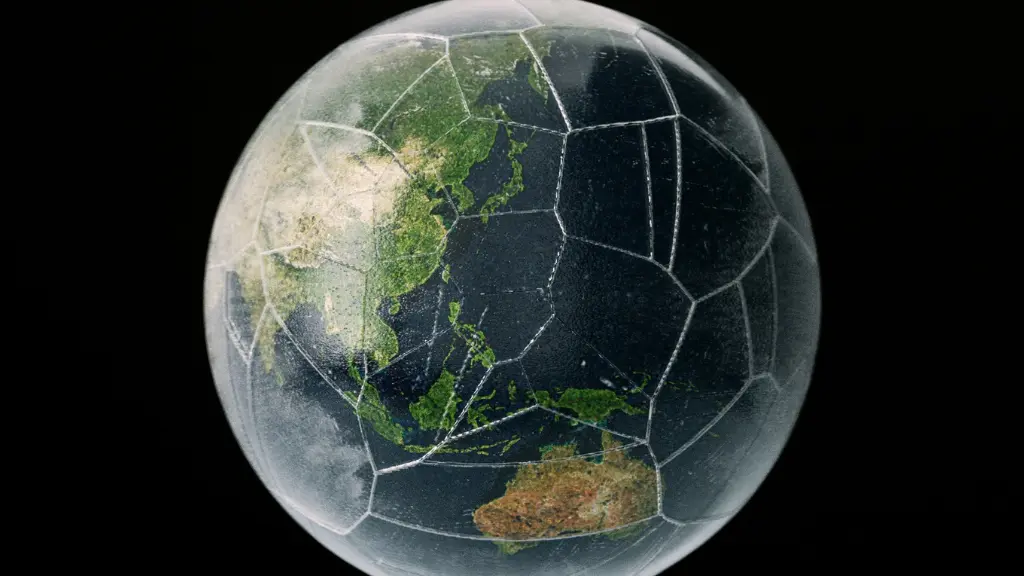

Der Erdkern ist ein faszinierender und geheimnisvoller Teil unseres Planeten. Als Mittelpunkt der Erdkernspielt es eine entscheidende Rolle in der Gesamtstruktur und dem Verhalten des Planeten. Der Kern besteht aus zwei unterschiedlichen Teilen: dem inneren Kern und dem äußeren Kern.
Der innere Kern ist eine feste Kugel aus Eisen und Nickel mit einem Durchmesser von etwa 1.200 Kilometern. Er ist vom äußeren Kern umgeben, einer Schicht aus geschmolzenem Metall, die etwa 2.300 Kilometer dick ist. Zusammen machen diese beiden Schichten etwa 15% des gesamten Erdvolumens aus. Der Kern ist außerdem unglaublich heiß, mit Temperaturen von bis zu 6.000 Grad Celsius im Zentrum.
Wissenschaftler erforschen den Erdkern seit Jahrzehnten, aber vieles ist noch immer unbekannt. Dank jüngster technologischer Fortschritte konnten Forscher diese geheimnisvolle Region jedoch besser verstehen. In diesem Artikel werde ich den Erdkern genauer untersuchen, einschließlich seiner Zusammensetzung, seines Verhaltens und der Rolle, die er bei der Gestaltung unseres Planeten spielt.

Der Erdkern ist der zentrale Teil unseres Planeten und befindet sich unter dem Erdmantel und der Erdkruste. Er ist in zwei Schichten unterteilt: den festen inneren Kern und den flüssigen äußeren Kern. Die Zusammensetzung des Erdkerns ist für Wissenschaftler von großem Interesse, da sie uns hilft, die Entstehung und Entwicklung unseres Planeten zu verstehen.
Die chemische Zusammensetzung des Erdkerns besteht vermutlich hauptsächlich aus Eisen (Fe) und Nickel (Ni). Diese Elemente machen mehr als 80% der Masse des Kerns aus, kleinere Mengen anderer Elemente wie Schwefel (S), Sauerstoff (O) und Silizium (Si). Die genaue Zusammensetzung des Kerns ist schwer zu bestimmen, da es unmöglich ist, ihn direkt zu beobachten. Wissenschaftler konnten jedoch anhand seismischer Daten und Experimente Rückschlüsse auf die Zusammensetzung des Kerns ziehen.
Der feste innere Erdkern besteht vermutlich hauptsächlich aus Eisen, mit kleineren Mengen Nickel und anderen Elementen. Sein Radius wird auf etwa 1.220 Kilometer geschätzt und seine Temperatur liegt bei etwa 5.000 Grad Celsius. Trotz seiner hohen Temperatur bleibt der innere Kern aufgrund des enormen Drucks, dem er ausgesetzt ist, fest.
Der flüssige äußere Erdkern besteht ebenfalls hauptsächlich aus Eisen und Nickel, enthält aber auch leichtere Elemente wie Schwefel und Sauerstoff. Er ist schätzungsweise etwa 2.300 Kilometer dick und etwa 4.000 Grad Celsius heiß. Vom äußeren Erdkern wird auch das Magnetfeld der Erde erzeugt, das uns vor der gefährlichen Sonnenstrahlung schützt.
Abschließend ist die Zusammensetzung der Erdkern besteht hauptsächlich aus Eisen und Nickel, mit kleineren Mengen anderer Elemente. Der feste innere Kern und der flüssige äußere Kern spielen eine wichtige Rolle in der Geologie der Erde und im magnetischen Kernfeld der Erde. Um die Zusammensetzung und das Verhalten des Erdkerns vollständig zu verstehen, sind weitere Forschungen erforderlich.

Als Geophysiker war ich schon immer von der Dynamik des Erdkerns fasziniert. Der Kern ist ein komplexes System, das aus zwei unterschiedlichen Schichten besteht, dem inneren Kern und dem äußeren Kern. In diesem Abschnitt werde ich die Bewegungen und die Wärmeübertragung innerhalb des Kerns untersuchen.
Der Erdkern ist ständig in Bewegung. Das Erdmagnetfeld, das uns vor gefährlicher Sonnenstrahlung schützt, wird vom äußeren Erdkern erzeugt. Die Bewegung des äußeren Kerns wird durch die vom inneren Kern erzeugte Wärme und die Abkühlung des äußeren Kerns an der Oberseite angetrieben. Diese Bewegung wird als Konvektion bezeichnet.
Auch die Rotation der Erde spielt bei der Bewegung des Erdkerns eine wichtige Rolle. Der Coriolis-Effekt bewirkt, dass die Konvektionsströme auf der Nordhalbkugel im Uhrzeigersinn und auf der Südhalbkugel gegen den Uhrzeigersinn rotieren. Diese Rotation erzeugt einen Dynamoeffekt, der das Magnetfeld der Erde erzeugt.
Der innere Kern hingegen rotiert unabhängig vom äußeren Kern. Die Rotation des inneren Kerns ist etwas schneller als die Rotation der Erdoberfläche und vollführt alle 24 Stunden eine vollständige Rotation. Diese Rotation erzeugt eine kleine Menge Energie, die vermutlich für die Aufrechterhaltung des Magnetfelds des Kerns verantwortlich ist.
Im Erdkern herrscht eine extrem heiße Atmosphäre, die Temperaturen erreichen bis zu 6.000 Grad Celsius. Die Hitze entsteht durch den Zerfall radioaktiver Isotope und Restwärme aus der Entstehung der Erde. Die Hitze wird dann durch Wärmeleitung vom inneren zum äußeren Kern übertragen.
Durch die Abkühlung des äußeren Kerns an der Oberseite entsteht ein Temperaturgradient, der die Konvektionsströme antreibt. Wenn das heiße Material aufsteigt, kühlt es ab und sinkt wieder nach unten, wodurch ein kontinuierlicher Zyklus der Wärmeübertragung entsteht.
Zusammenfassend lässt sich sagen, dass die Dynamik des Erdkerns ein komplexes System aus Bewegungen und Wärmeübertragung ist. Die Bewegungen des Kerns werden durch Konvektion und die Rotation der Erde angetrieben, während die Wärme durch den Zerfall radioaktiver Isotope und Restwärme aus der Entstehung der Erde erzeugt wird. Das Verständnis der Dynamik des Kerns ist entscheidend für das Verständnis des Erdmagnetfelds und der Prozesse, die unseren Planeten formen.

Als Geowissenschaftler finde ich die Erforschung des Erdmagnetfelds faszinierend. Das Magnetfeld ist ein wichtiger Aspekt unseres Planeten und spielt in unserem täglichen Leben eine entscheidende Rolle. In diesem Abschnitt werde ich die Rolle des Erdkerns bei der Erzeugung und Aufrechterhaltung des Magnetfelds besprechen.
Das Magnetfeld der Erde entsteht durch die Bewegung von geschmolzenem Eisen im äußeren Erdkern. Der äußere Erdkern ist eine Schicht aus flüssigem Eisen, die den festen inneren Erdkern umgibt. Die Bewegung des geschmolzenen Eisens erzeugt elektrische Ströme, die wiederum das Magnetfeld erzeugen.
Das Magnetfeld ist nicht statisch, sondern verändert sich ständig. Die Magnetpole können sich mit der Zeit bewegen und sogar ihre Polarität umkehren. Diese Veränderungen sind auf die komplexe Dynamik des Erdkerns und seine Wechselwirkungen mit dem Erdmantel und der Erdkruste zurückzuführen.
Geomagnetische Umkehrungen sind die dramatischsten Veränderungen im Magnetfeld der Erde. Bei einer Umkehrung wird das Magnetfeld schwächer und die magnetischen Pole tauschen ihre Plätze. Die letzte Umkehrung fand vor etwa 780.000 Jahren statt und Wissenschaftler versuchen immer noch, die Mechanismen zu verstehen, die diese Umkehrungen verursachen.
Einer Theorie zufolge werden die Umkehrungen durch Veränderungen im Fluss des geschmolzenen Eisens im äußeren Kern verursacht. Wenn sich der Fluss ändert, wird das Magnetfeld schwächer und kehrt sich schließlich um. Eine andere Theorie besagt, dass die Umkehrungen durch die Wechselwirkungen zwischen Kern und Mantel verursacht werden.
Zusammenfassend lässt sich sagen, dass das Magnetfeld des Erdkerns ein komplexes und dynamisches System ist, das durch die Bewegung von geschmolzenem Eisen im äußeren Kern erzeugt und aufrechterhalten wird. Das Magnetfeld spielt in unserem täglichen Leben eine entscheidende Rolle, von der Orientierung des Kompasses bis hin zum Schutz vor schädlicher Sonnenstrahlung. Das Verständnis der Rolle des Kerns im Erdmagnetismus ist ein wichtiges Forschungsgebiet für Geowissenschaftler.

Als Geowissenschaftler finde ich die Erforschung des Erdkerns faszinierend. Der Erdkern ist der innerste Teil unseres Planeten und besteht aus einem festen inneren Kern und einem flüssigen äußeren Kern. Der Kern macht etwa 15% des Erdvolumens und 32% ihrer Masse aus. Trotz seiner Bedeutung ist die Erforschung des Erdkerns aufgrund seiner Unzugänglichkeit eine anspruchsvolle Aufgabe.
Eine der wichtigsten Methoden zur Untersuchung des Erdkerns ist die seismische Wellenanalyse. Seismische Wellen sind Energiewellen, die sich durch das Erdinnere bewegen und wertvolle Informationen über die Eigenschaften des Erdkerns liefern können. Durch die Analyse der Laufzeiten und Amplituden seismischer Wellen können Wissenschaftler Rückschlüsse auf die Dichte, Temperatur und Zusammensetzung des Erdkerns ziehen.
Eine weitere Methode zur Untersuchung des Erdkerns ist die Computersimulation. Dabei wird das Verhalten des Erdkerns unter verschiedenen Bedingungen mithilfe von Computermodellen simuliert. Durch die Variation von Parametern wie Temperatur, Druck und Zusammensetzung können Wissenschaftler Einblicke in die Dynamik des Erdkerns und seinen Einfluss auf das Erdmagnetfeld gewinnen.
Zusammenfassend lässt sich sagen, dass die Untersuchung des Erdkerns eine komplexe und anspruchsvolle Aufgabe ist, die den Einsatz mehrerer Methoden und Techniken erfordert. Durch die Analyse seismischer Wellen und Computersimulationen gewinnen Wissenschaftler ein besseres Verständnis des Erdkerns und seiner Rolle bei der Gestaltung des Planeten, auf dem wir leben.

Als jemand, der den Erdkern studiert hat, kann ich mit Sicherheit sagen, dass der Kern einer der faszinierendsten und wichtigsten Teile unseres Planeten ist. Er befindet sich im Zentrum der Erde und besteht aus zwei Erdschichten: dem inneren Kern und dem äußeren Kern.
Die Grenze zwischen Erdkern und Erdmantel wird als Kern-Mantel-Grenze bezeichnet. Sie befindet sich etwa 2.900 Kilometer unter der Erdoberfläche. Die Grenze ist durch eine starke Zunahme der Dichte und eine Änderung im Verhalten seismischer Wellen gekennzeichnet, die sie durchqueren.
Die Kern-Mantel-Grenze ist ein sehr wichtiges Studiengebiet für Geologen und Seismologen. Man geht davon aus, dass die Grenze eine entscheidende Rolle bei der Bewegung tektonischer Platten und der Entstehung vulkanischer Aktivität spielt. Man geht auch davon aus, dass die Grenze für die Entstehung des Magnetfelds der Erde verantwortlich ist.
Auch die Wechselwirkungen zwischen Erdkern und Erdkruste sind sehr wichtig. Die Wärme des Erdkerns treibt die Bewegung tektonischer Platten an, die wiederum die Erdoberfläche formen. Der Erdkern spielt auch bei der Bildung von Bergen eine Rolle, da die Bewegung tektonischer Platten dazu führen kann, dass sich die Erdkruste verbiegt und faltet.
Darüber hinaus ist das Erdmagnetfeld dafür verantwortlich, die Erde vor den schädlichen Auswirkungen des Sonnenwinds und der kosmischen Strahlung zu schützen. Ohne dieses Magnetfeld wäre das Leben auf der Erde viel schwieriger, wenn nicht gar unmöglich.
Insgesamt ist der Erdkern ein entscheidender Teil des Erdinneren. Seine Wechselwirkungen mit dem Erdmantel und der Erdkruste sind für viele der geologischen Prozesse verantwortlich, die unseren Planeten formen. Durch kontinuierliches Studium und Forschung können wir den Kern und seine Rolle in der Geschichte und Zukunft unseres Planeten besser verstehen.

Als jemand, der den Erdkern studiert hat, kann ich mit Sicherheit sagen, dass er einen erheblichen Einfluss auf Oberflächenphänomene hat. In diesem Abschnitt werde ich zwei wichtige Arten diskutieren, in denen der Kern die Erdoberfläche beeinflusst: vulkanische Aktivität und tektonische Bewegungen.
Der Erdkern spielt eine entscheidende Rolle bei der Entstehung vulkanischer Aktivität. Magma, geschmolzenes Gestein, das sich unter der Erdoberfläche befindet, entsteht durch das Schmelzen von Gesteinen im Erdmantel und in der Erdkruste. Dieses Schmelzen wird durch die hohen Temperaturen und Drücke verursacht, die tief im Inneren der Erde herrschen und letztendlich durch die vom Kern freigesetzte Wärme erzeugt werden.
Der Erdkern beeinflusst auch die Zusammensetzung des Magmas. Der Kern besteht hauptsächlich aus Eisen und Nickel, und diese Elemente gelten als Quelle des im Magma enthaltenen Eisens und Nickels. Darüber hinaus kann das Magnetfeld des Kerns die Bewegung des Magmas beeinflussen, was wiederum den Ort und die Intensität von Vulkanausbrüchen beeinflussen kann.
Der Erdkern spielt auch eine bedeutende Rolle bei tektonischen Bewegungen, also den Bewegungen der Erdkrustenplatten. Die Hitze des Kerns gilt als Hauptantrieb dieser Bewegungen, da sie Konvektionsströme im Erdmantel verursacht. Diese Ströme wiederum treiben die Bewegung der Erdkrustenplatten an.
Der Erdkern beeinflusst auch die Zusammensetzung und Festigkeit der Krustenplatten. Die vom Kern erzeugte Hitze führt dazu, dass die Gesteine im Mantel und in der Kruste dehnbarer werden, was bedeutet, dass sie leichter verformbar sind. Dies kann zur Bildung von Verwerfungen und Brüchen in den Krustenplatten führen, die letztendlich zu Erdbeben führen können.
Zusammenfassend lässt sich sagen, dass der Erdkern einen erheblichen Einfluss auf Oberflächenphänomene hat, insbesondere auf vulkanische Aktivitäten und tektonische Bewegungen. Das Verständnis der Rolle des Erdkerns in diesen Prozessen ist entscheidend für die Vorhersage und Milderung der Auswirkungen von Naturkatastrophen wie Vulkanausbrüchen und Erdbeben.

Als Geologe finde ich den Erdkern ein faszinierendes Thema. Er beeinflusst nicht nur das Magnetfeld des Planeten, sondern hat auch Auswirkungen auf die Ozeane. In diesem Abschnitt werde ich die Beziehung zwischen dem Erdkern und den Ozeanen besprechen.
Der Erdkern erzeugt Wärme, die durch Konvektion an die Oberfläche übertragen wird. Diese Wärme treibt die thermohaline Zirkulation an, die für die Bewegung des Wassers in den Ozeanen verantwortlich ist. Die thermohaline Zirkulation wird durch Temperatur- und Salzgehaltsunterschiede angetrieben, die Dichtegradienten im Ozean erzeugen.
Das warme Wasser vom Äquator fließt in Richtung der Pole, wo es abkühlt und auf den Meeresboden sinkt. Dieses kalte Wasser fließt dann zurück zum Äquator, wodurch der Kreislauf abgeschlossen wird. Dieser Prozess spielt eine entscheidende Rolle bei der Regulierung des Erdkernklimas, indem er Wärme rund um den Planeten verteilt.
Auch der Erdkern hat Einfluss auf den Meeresspiegel. Die Anziehungskraft von Mond und Sonne verursacht Gezeiten, die wiederum durch Veränderungen im Erdmagnetfeld beeinflusst werden können. Das Magnetfeld wird durch die Bewegung von geschmolzenem Eisen im Erdkern erzeugt, das wiederum durch äußere Faktoren wie Sonnenstürme beeinflusst werden kann.
Veränderungen des Meeresspiegels können auch durch das Schmelzen von Gletschern und Eiskappen verursacht werden, das vom Erdkern beeinflusst wird. Das Schmelzen von Eis kann Veränderungen in der Massenverteilung auf der Erdkernoberfläche verursachen, was wiederum die Rotation und das Gravitationsfeld des Planeten beeinflussen kann.
Zusammenfassend lässt sich sagen, dass der Erdkern eine bedeutende Rolle für die Funktion der Ozeane spielt. Die thermohaline Zirkulation und die Veränderungen des Meeresspiegels sind nur zwei Beispiele für die komplexe Beziehung zwischen dem Erdkern und den Ozeanen. Als Geologe halte ich diese Beziehung für ein faszinierendes Thema für weitere Studien.

Als Forscher in der Erdkernforschung bin ich gespannt auf die zukünftigen Möglichkeiten der Erforschung und Entdeckung. Es gibt noch so viel, was wir über die inneren Vorgänge unseres Planeten nicht wissen, und ich glaube, dass weitere Forschung und Erkundung zu neuen Erkenntnissen und einem tieferen Verständnis des Erdkerns führen werden.
Ein Bereich von besonderem Interesse ist die Untersuchung seismischer Wellen. Durch die Analyse der Art und Weise, wie sich seismische Wellen durch den Erdkern bewegen, können wir wertvolle Informationen über die Zusammensetzung und Struktur des Kerns gewinnen. Laufende Forschung auf diesem Gebiet könnte zu neuen Erkenntnissen über die Eigenschaften des Kerns und die darin stattfindenden Prozesse führen.
Ein weiterer vielversprechender Ansatz für zukünftige Forschungen ist die Verwendung von Computermodellen und -simulationen. Indem wir detaillierte Modelle des Erdkerns erstellen, können wir das Verhalten verschiedener Materialien simulieren und verschiedene Hypothesen über Kernprozesse testen. Dieser Ansatz hat bereits einige spannende Ergebnisse hervorgebracht, und ich bin überzeugt, dass weitere Investitionen in diesem Bereich zu noch mehr Durchbrüchen führen werden.
Darüber hinaus bin ich davon überzeugt, dass wir durch die direkte Erforschung des Erdkerns noch viel lernen können. Dies ist zwar eine gewaltige Aufgabe, aber es entstehen neue Technologien und Techniken, die dies möglich machen könnten. So könnte uns beispielsweise die Entwicklung moderner Bohrtechniken und -materialien ermöglichen, tiefer in die Erdkruste einzudringen und den Kern zu erreichen. Ebenso könnten uns Fortschritte in der Robotik und Fernerkundung ermöglichen, den Kern zu erforschen, ohne ihn physisch zu betreten.

Insgesamt bin ich optimistisch für die Zukunft von Erdkern Wissenschaft und das Potenzial für neue Entdeckungen und Erkenntnisse. Indem wir weiterhin in Forschung und Erkundung investieren, können wir unser Verständnis unseres Planeten und der Kräfte, die ihn formen, vertiefen. Weitere Artikel wie diesen finden Sie hier: Cole Parmer Antylia: Eine ausführliche Rezension.